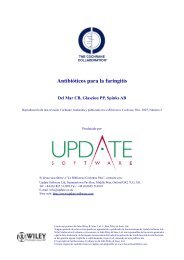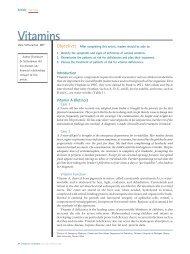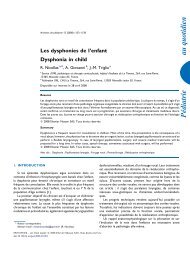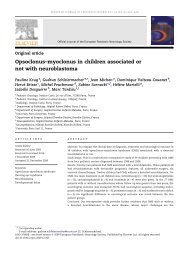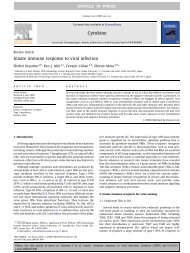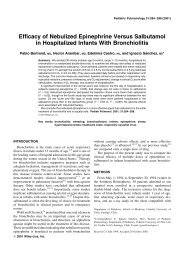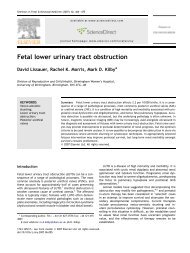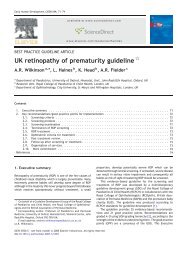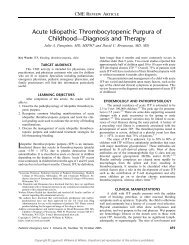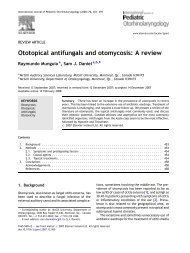Mini Review - sepeap
Mini Review - sepeap
Mini Review - sepeap
You also want an ePaper? Increase the reach of your titles
YUMPU automatically turns print PDFs into web optimized ePapers that Google loves.
356 Nader: Adrenarche And Polycystic Ovary Syndrome<br />
advanced bone age, had augmented LH (and also FSH<br />
in one of the boys) during sleep at ages 8.5 and 5.5<br />
years. In the same landmark study 34 quoted above,<br />
there were nine females with idiopathic sexual precocity<br />
with onset between the ages of 6e8 years. All had<br />
Tanner stage 2e3 pubic hair, six had Tanner stage 3<br />
and three Tanner stage 2 breasts. These nine had advanced<br />
bone age and significantly greater DHEA-S<br />
concentrations than chronologic-age-matched controls;<br />
these concentrations were similar to those of normal<br />
children matched for bone age. As written by Sklar<br />
et al., 34 ‘‘These patients exhibited appropriate concordance<br />
between adrenal androgen and gonadal steroid<br />
concentrations. At least some of the patients with onset<br />
of idiopathic precocious puberty between 6 and 8 yr of<br />
age may represent one end of the normal spectrum of<br />
puberty development, their precocious puberty being<br />
part of a more generalized process which includes precocious<br />
activation of both gonadarche and adrenarche.’’<br />
The association between premature pubarche, as<br />
a result of early or amplified adrenarche, and early<br />
menarche was clearly demonstrated in a longitudinal<br />
study of 187 girls with premature pubarche. 43 The authors<br />
showed that menarche before age 12 was twofold<br />
more prevalent in these girls than in normal<br />
controls and was threefold more prevalent in a group<br />
of girls with both premature pubarche and low birth<br />
weight. Thus, while adrenarche and gonadarche can<br />
occur independently, are controlled and initiated by<br />
separate mechanisms, and have separate pathways, 44<br />
there appears to be a temporal link between adrenarche<br />
and gonadarche: early adrenarche is associated<br />
with earlier gonadarche and conversely delayed or<br />
inadequate adrenarche with later gonadarche.<br />
The biochemical evidence supporting a role for<br />
adrenarche in the onset of gonadarche, that is, a role<br />
for androgens in the establishment of gonadal axis<br />
maturation, is circumstantial. The progression of<br />
changes in neuroendocrine function in normal puberty<br />
will first be briefly discussed. This topic was elegantly<br />
reviewed by Blank et al. 45 They stated that the juvenile<br />
period of childhood is characterized by low levels<br />
of LH and FSH with approximately one pulse of<br />
GnRH every 4e6 hours. With the onset of puberty,<br />
nocturnal sleep-associated increases in LH pulse<br />
amplitude and frequency occur and precede pubertal<br />
maturation by about two years. LH pulse frequency<br />
and amplitude increases four- and nine-fold across pubertal<br />
maturation in girls. These nocturnal increases<br />
in LH lead to early morning increase in estradiol, progesterone<br />
and testosterone. 46,47 It has been proposed<br />
that, over time, the morning increases in progesterone<br />
contribute to the reduction in GnRH and LH pulsatility<br />
the following day, favoring FSH synthesis and thus<br />
follicular development, progesterone acting either directly<br />
or indirectly on the GnRH pulse generator. 47<br />
Androgens have been known to play a role in<br />
GnRH pulsatility. As previously stated, testosterone<br />
treatment of adolescent boys with constitutional delay<br />
has been shown to increase the tempo of testicular enlargement,<br />
as compared with control subjects. 42 This<br />
earlier gonadarche can only relate to central axis activation.<br />
In addition, it has long been known that<br />
women with PCOS require higher concentrations of<br />
progesterone to achieve the same degree of suppression<br />
of GnRH pulsatility as normal ovulatory control<br />
subjects. 48 This sensitivity is restored by the antiandrogen<br />
flutamide, implying that decreased progesterone<br />
sensitivity is secondary to hyperandrogenemia. 49<br />
Stated differently, androgens seem to be associated<br />
with a disinhibition of GnRH, with increased GnRH<br />
pulsatility, this also being a marker of the onset of gonadarche.<br />
In light of these observations, it is quite<br />
possible that the gradual increase in androgens characteristic<br />
of normal puberty 50 could potentially mediate<br />
this reduction of feedback sensitivity, leading to<br />
increased GnRH pulsatility, as was suggested by<br />
Blank et al. 45 In support of this possibility, Blank<br />
and colleagues performed a study on normal adolescent<br />
girls given estradiol and progesterone and<br />
showed that hypothalamic progesterone sensitivity<br />
(the ability of progesterone to inhibit GnRH pulsatility)<br />
decreases as puberty progresses, this being coincident<br />
with a rise in serum testosterone. They also<br />
showed that hypothalamic progesterone sensitivity is<br />
further reduced in adolescent girls with androgen<br />
excess (presented at the 88 th annual meeting of the<br />
Endocrine Society, Boston, June 2006, p 2-622).<br />
The hypothesis proposed there is that adrenarche,<br />
which precedes gonadarche, provides the initial<br />
source of androgens, leading to the disinhibition of<br />
GnRH, and hence gonadarche. The progression of<br />
the gonadal events of puberty, as outlined in the section<br />
on reproductive competence, and also above,<br />
would thus naturally follow the production of androgens<br />
at adrenarche, a harbinger of gonadarche. In<br />
the absence of adrenarche, as in patients with<br />
Addison’s disease for example, one would have to<br />
assume that other mechanisms such as the accrual<br />
of body fat and leptin activate the hypothalamic pulse<br />
generator, albeit later. 51,52<br />
Transition from Adrenarche to Full Reproductive<br />
Competence<br />
As outlined in the sections on reproductive competence<br />
and adrenarche, normal pubertal development starts<br />
with adrenarche and ends with the attainment of full reproductive<br />
competence, that is, persistent ovulation, in<br />
women. In the early phase of puberty, there is relative<br />
hyperandrogenism, with high levels of androgens relative<br />
to estrogens, as demonstrated in a study of 56




